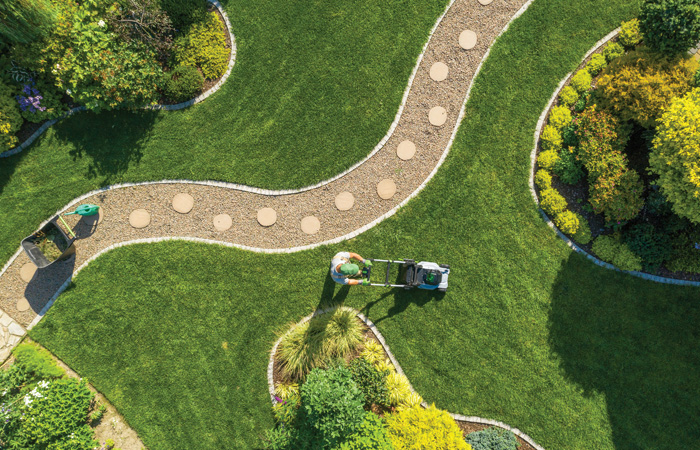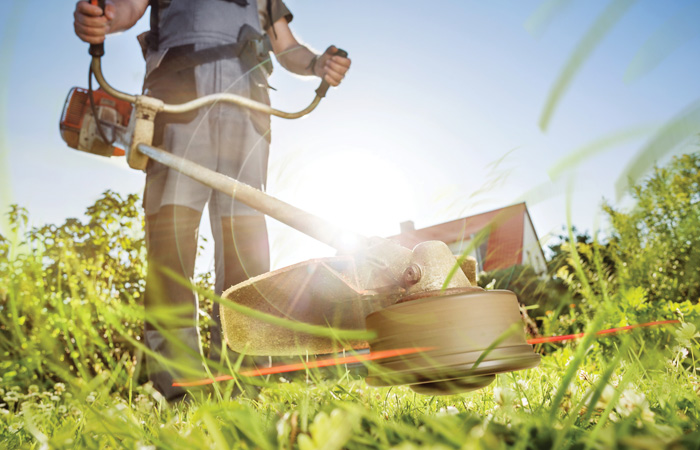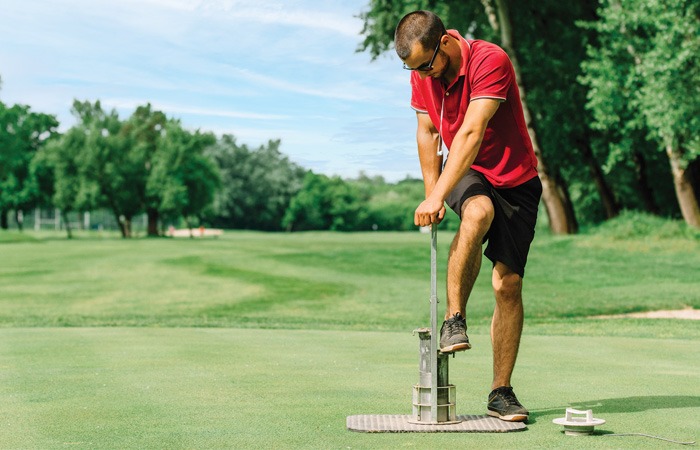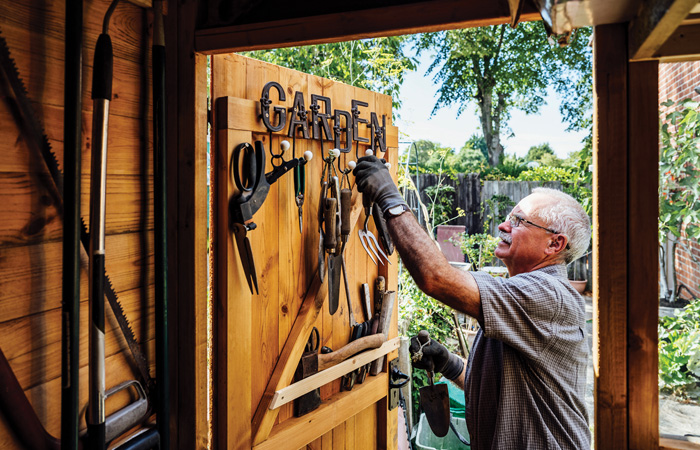What Tools Do I Need to Maintain
My Lawn and Landscape?
Welcome to the official start of summer (June 21 is actually the first day of the season). With the longest hours of daylight of the year, there is so much more time to golf. However, with the temperatures up and an occasional thunder shower providing fuel to your ever-growing landscape, North Texans are faced with many green chores this time of year. From mowing, edging and weed-eating lawns to pruning trees and shrubbery, the list is long, and it takes away from other more recreational pursuits. It is no surprise that the question I get most this time of year is what is the best equipment for my home lawn/landscape care? I will refrain from giving you guys a single brand or model number recommendation, but rather we will focus on the type and specifics of equipment that will allow you to be effective and safe while manicuring your lawn and landscape this summer.

Home Lawn and Landscape Tool Essentials
When it comes to buying lawn and landscape tools, there are a few basic guidelines that are essential to success. The first rule is to always buy the highest-quality tools you can afford. Shop prices, both online and in-store. Ask your friends and neighbors what they recommend and have had success with. Check social media sites for ratings and details on operation. Quality tools will last a long time and offer safe and consistent function, so focus on the total value of the purchase, not the upfront cost. All of these tools are available at your local hardware store, small-engines dealer or garden center. Here is a basic list of things you should have to maintain a quality residential lawn and landscape:
Lawn Mower (walking or riding rotary mower, depending on the size of the lawn)
Weed-Eater (for trimming lawns and edging sidewalks and driveways)
Blower (hand-held or backpack to remove debris)
Rotary Spreader (for applying granular fertilizers and pesticides)
Sprayer (3-gallon hand pump or electric sprayer for applying liquid fertilizers and pesticides)
Personal Protection Equipment or PPE (safety glasses, gloves, hat, chaps and any PPE mentioned on a pesticide label for safe application)
Shovels (round-tip, square-tip and hand-spade for planting flowers, etc.)
Rakes (short tooth and leaf rake)
Pruners (hand, lopper, hedge and pole pruners for small/large trees and shrubs)
Chain Saw (if you have a lot of trees on your property, gas or brushless electric work great)
Wheel Barrow (moving heavy loads)
Specialty items (PVC pipe cutter, hack saw, hammer, tape measure, 5-gallon bucket(s), heavy trash/debris bags, etc.)
Gas Can(s) (spill-resistant containers marked by fuel type, such as regular gas and mixed gas for weed-eaters and blowers)
Storage Shed or designated area to store your tools
Residential Lawn Mowers 101
Residential lawn mowers come in many shapes and sizes. In general, we recommend at least a 20” cutting width for walking lawn mowers and a 48” cutting width for riding lawn mowers. We also recommend a mulching blade or blades (many mowers come with mulching blades installed from the factory) be installed on the mower to improve the quality of cut and the dispersal of lawn clippings. Remember your basic agronomy and never remove more than ⅓ of the turf leaf blade in a single mowing! Basic walking mowers are available with self-propel options, which are certainly worth the money if you have a medium-sized yard or just want to have a little help pulling the slopes. Riding lawn mowers and zero-turn mowers could be required for larger yards, but usually walking mowers are great for the average residential lawn in DFW. You also have some options when it comes to fuel. The standard gasoline mowers never go out of style, but now with the advances in lithium batteries there are several worthy options for battery-powered lawn mowers. Remember that the cost of an electric mower is more expensive, but you are buying your fuel upfront and can eliminate storing gas on your property, which is an advantage. Note that the larger the horsepower, the larger the jobs the mower can handle. On average, walking mowers are between 3 and 4 horsepower and riding mowers are between 20 and 40 horsepower.

Weed-Eaters and Blowers
When buying a weed-eater, the most common mistake is buying one that is too small. Buy the largest cubic centimeters or cc (25cc is a good choice, or at least 40 volts for electric) you can afford; you will not regret it! Another important feature when choosing a weed-eater is making sure it has a good weed guard to protect you from flying debris. It is also important that the weed eater is ergonomically a good fit so that you can handle it safely and efficiently. Also choose a monofilament line (0.080” is average) that is recommended for your size weed-eater. Blowers are also available in many shapes and sizes. Usually we recommend at least 350 cubic feet per minute (CFM) for hand-blowers and 650 CFM for backpack blowers; and, again, these are available in battery-operated or traditional mixed-gas models. You will know in one minute of use if your blower is too small for your projects.

Spreaders and Sprayers
Spreaders are critical for evenly applying granular fertilizers/pesticides uniformly at the right rate. Rotary spreaders are ideal for residential situations, as they are affordable, durable and easy to calibrate (go to our February article for calibration instructions). Make sure your spreader has a large hopper (holds up to 50 pounds) and sturdy wheels, with easy-to-adjust spreader settings. Most homeowners do not need large sprayers, but a good 3-gallon hand pump or electric sprayer is perfect to spot-treat lawns and plants. Be sure to triple rinse and clean your sprayer after each use, and inspect it regularly for leaks or clogged nozzles or hoses. Follow all PPE and label recommendations when applying chemicals and fertilizers.
Shovels and Rakes
Shovels and rakes are the most iconic of lawn and landscape tools. They are basic by nature but they are not all created equally. Be sure that the metals in the head pieces are solid and durable and, most importantly, make sure the handles are of high quality, either wood, steel or fiberglass. These tools do the heaviest jobs in the landscape, so cheaper-made options brake easily and ultimately cost more. Pro tip: wrap the handles with spiraled electric tape for better grip and easy ID at a distance.

Pruners and Saws
The most dangerous tools used on the landscape are the pruners and saws, as they are designed to cut and, ironically, the dull and poorly maintained ones are the most dangerous. Buy only high-quality pruners or saws from reputable dealers and keep them sharp and rust-free. Usually, a pair of scissor hand pruners, a medium to large lopper and a sturdy extension pole saw are all most homeowners need. If you do have need for a chain saw, stick to the name brands (Stihl, Echo, Ryobi), make sure it is light enough to be handled safely and wear PPE, such as chain-resistant chaps, gloves and safety glasses. If you buy an electric chainsaw, the brushless models are best.
Specialty and Miscellaneous Items
You will need a few specialty tools to make things easier. Wheelbarrows are handy; just make sure the wheel and frame are sturdy. You will also need an assortment of hand tools, such as PVC cutter (to repair irrigation or plumbing), hammer, hack saw, tape measure and a good, old 5-gallon bucket for weeding, watering or just moving your tools. Heavy-duty trash bags are also helpful, especially during leaf season. Remember to buy the best quality you can afford, even with small tools.
Storing Your Lawn and Landscape Equipment
There are many ways to store your equipment. In the garage or other area in the house works, but many avid gardeners love the legendary garden shed. The shed can be traditional wood frame and siding or metal. They can be large or small, with 8’X10’ being the most popular. You can customize these with tool racks or shelves. I have seen many garden or storage sheds that were as unique as the gardens they serve. My personal garden shed is a mix of function and aesthetics and is a metal, build-it-yourself kit.

That was a lot of ground to cover, but I hope that you found the information helpful. The take-aways this month are that you will need tools of various types and sizes to be successful as an avid home lawn and garden expert. Ask friends, do online research or consult an in-store professional for recommendations … and always buy the best you can afford. Be sure to customize your tools, shed and garden as much as possible. It will add to the enjoyment and value.
And be sure to play lots of golf during the long days of June … and keep reading AVIDGOLFER magazine for more tips and advice.